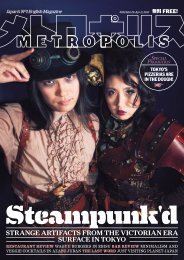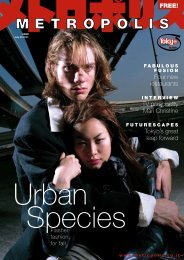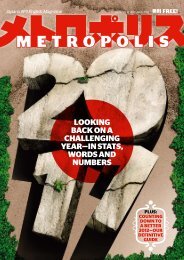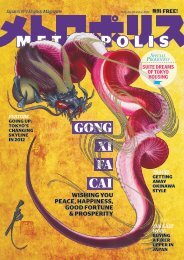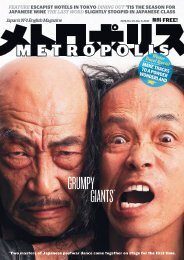Art Music the lAst Word sports **dining** - Metropolis
Art Music the lAst Word sports **dining** - Metropolis
Art Music the lAst Word sports **dining** - Metropolis
Create successful ePaper yourself
Turn your PDF publications into a flip-book with our unique Google optimized e-Paper software.
art<br />
Yoshitomo<br />
Nara<br />
coming back to kawaii<br />
in yokohama<br />
By C. B. Liddell<br />
For better or worse, yoshitomo nara’s art has<br />
become part of <strong>the</strong> new face of Japan, a country<br />
that is now associated with manga, otaku,<br />
and all things kawaii, ra<strong>the</strong>r than <strong>the</strong> outmoded<br />
salaryman stereotypes of <strong>the</strong> 20th century.<br />
it is a Japan that can’t so much say “no” to America<br />
as one that instead rolls its oversized anime eyes, bites<br />
its lip childishly, and says, “Goo!” in this sense nara’s art,<br />
with its cartoon-like depictions of cute little girls with<br />
a hint of naughtiness and a touch of evil, is a perfect fit<br />
for <strong>the</strong> image of <strong>the</strong> new, infantilized Japan—several<br />
removes from its proud samurai past.<br />
but <strong>the</strong>re have been signs that this artistic approach<br />
has not really been working for nara, especially when<br />
things “get serious” as <strong>the</strong>y clearly did last year with <strong>the</strong><br />
Great eastern Japan earthquake. in <strong>the</strong> aftermath of<br />
that mega-tragedy, painting cutesy caricatures of little<br />
girls must have seemed redundant, which is why he<br />
stopped painting for several months.<br />
<strong>sports</strong><br />
searchiNG<br />
For a<br />
YokuzuNa<br />
<strong>the</strong> quest to be sumo<br />
grand champion<br />
at tokyo’s autumn<br />
tournament<br />
By Mark Buckton<br />
Most Japanese will tell you that sumo is<br />
<strong>the</strong> national sport. it is not, and never<br />
has been—few nations on earth have<br />
passed legislation to this effect.<br />
it is, however, recognized as something just a little<br />
bit “more” than a sport by most, what with men weighing<br />
anything up to a quarter of a ton launching <strong>the</strong>mselves<br />
at each o<strong>the</strong>r after several minutes of slow and careful<br />
preparation. throw in a sizeable dollop of shinto-based<br />
pomp and ceremony, and it is one aspect of <strong>the</strong> local<br />
culture most first timers and tourists will never forget.<br />
And with september rolling around once again, so<br />
too arrives <strong>the</strong> holding of <strong>the</strong> latest Aki Basho (Autumn<br />
tournament) at <strong>the</strong> ryogoku kokugikan, from september<br />
9 to 23.<br />
With sumo tournaments held every two months,<br />
and with a mongolian ozeki, harumafuji, winning <strong>the</strong><br />
July basho down in nagoya, all eyes will be on <strong>the</strong> 129kg<br />
lightweight to see if he can win back-to-back tourneys<br />
and thus guarantee himself promotion to yokozuna—a<br />
<strong>the</strong> large solo exhibition of his work at <strong>the</strong> yokohama<br />
museum of <strong>Art</strong> charts his route back to painting<br />
via sculpture, a new medium of expression for <strong>the</strong> artist.<br />
subtitled “A bit like you and me…” <strong>the</strong> exhibition seems<br />
to be employing <strong>the</strong> same techniques as nara’s subjects<br />
by trying to be cute and appeal to our sympathy, before<br />
getting up-close-and-personal with a life-sized recreation<br />
of his studio.<br />
but interesting as this is, <strong>the</strong> artistic reality is that<br />
<strong>the</strong>re are serious flaws with <strong>the</strong> giant sculptures that<br />
form this exhibition’s centerpiece. <strong>the</strong> key point about<br />
nara’s art has always been its cartoonish two-dimensional<br />
quality. transposing <strong>the</strong> flat spaces and naïve<br />
lines of his little ladies into 3-D creates something gross<br />
and off-putting.<br />
<strong>the</strong>re is a whole room of <strong>the</strong>se swollen-headed<br />
monstrosities at <strong>the</strong> exhibition, but, in accord with<br />
<strong>the</strong> wheedling, emotionally manipulative vibe of <strong>the</strong><br />
show, we are encouraged to judge <strong>the</strong>m not purely as<br />
artworks but also as “<strong>the</strong>rapy pieces” that helped nara<br />
return to painting. Actually, <strong>the</strong>y might have achieved<br />
this simply by demonstrating what an abysmal sculptor<br />
he is.<br />
As for his new drawings and paintings, some of<br />
<strong>the</strong>m like Miss Spring (2012) show signs of an enriched<br />
palette, with a few added touches of color in <strong>the</strong> hair<br />
and glitter in <strong>the</strong> eyes, but essentially his latest works<br />
show no advance or development. <strong>the</strong>se are still <strong>the</strong><br />
same iconic, naughty, little imps he was painting 20<br />
years ago; nebulous enough for visitors to associate<br />
with <strong>the</strong>ir own “mischievous darlings.”<br />
title usually translated as “grand champion” in english.<br />
should <strong>the</strong> fighter—who is known for his passion for<br />
painting—manage to triumph, his nationality will cause<br />
quite some consternation in <strong>the</strong> local media—since no<br />
Japanese sumo wrestler has been promoted to <strong>the</strong> top<br />
rank in <strong>the</strong> sport since 1998. Depending on whom you<br />
ask, this is ei<strong>the</strong>r something of a national embarrassment,<br />
or evidence that <strong>the</strong> world of sumo is opening its<br />
doors to <strong>the</strong> world.<br />
yokozuna Grand champion hakuho, a mongolian,<br />
dominates sumo today. in <strong>the</strong> second rank of ozeki,<br />
besides harumafuji, <strong>the</strong>re are five o<strong>the</strong>r fighters vying<br />
for promotion to yokozuna, of which just two are<br />
Japanese—kisenosato and kotoshogiku. <strong>the</strong> remaining<br />
trio is made up of an estonian (baruto), a bulgarian<br />
(kotooshu) and ano<strong>the</strong>r mongolian (kakuryu).<br />
come september 9, fans will be watching harumafuji<br />
in his quest for promotion. Whe<strong>the</strong>r or not he will<br />
repeat <strong>the</strong> perfect 15-0 score he put toge<strong>the</strong>r in nagoya<br />
remains to be seen, but in two previous attempts after<br />
winning his first two emperor’s cups he flopped badly—<br />
scoring 9-6 over 15 days of action in 2009, and 8-7 this<br />
time last year.<br />
<strong>the</strong> pressure will thus be on <strong>the</strong> man like never<br />
before. yokozuna hakuho and <strong>the</strong> rest of <strong>the</strong> men in <strong>the</strong><br />
ozeki rank are all approaching peak form, and <strong>the</strong>re is<br />
a talented crop of Japanese rikishi champing at <strong>the</strong> bit<br />
in <strong>the</strong> ranks below—all awaiting <strong>the</strong>ir own chance for<br />
advancement.<br />
myogiryu, Goeido, and chiyotairyu are all names<br />
outside <strong>the</strong> upper two ranks to keep an eye out for, as<br />
is osunaarashi (literally “big sandstorm”) way down in<br />
<strong>the</strong> Sandanme division, sumo’s fourth from top. egyptian<br />
by birth, he is <strong>the</strong> first African, first muslim and first<br />
from his nation to enter <strong>the</strong> professional game. to date,<br />
he has fought just 12 times and has yet to be defeated.<br />
he is one who will surely be making his way upward to<br />
<strong>the</strong> topmost Makunouchi division—home of hakuho,<br />
harumafuji and company—sooner, ra<strong>the</strong>r than later.<br />
courtesy of nihon sumo kyokAi<br />
Miss Spring (2012)<br />
<strong>the</strong> earthquake threw nara out of his cozy stride<br />
and even temporarily into <strong>the</strong> heroic world of sculpture,<br />
but this exhibition shows that normal service has<br />
been resumed. imagine a toddler who gets upset and<br />
bawls her head off for a few minutes before getting a<br />
nice candy from her mum. instantly, <strong>the</strong> dark shadows<br />
are dispelled, and <strong>the</strong> sunshine smile is resumed, perhaps<br />
with a hint of a cunning, manipulative leer. that<br />
naughty little miss is yoshitomo nara.<br />
Yokohama Museum of <strong>Art</strong>, until Sep 23. See exhibition<br />
listings (o<strong>the</strong>r areas) for details.<br />
Harumafuji has Hakuho on <strong>the</strong> back foot<br />
as Bulgarian Kotooshu looks on<br />
TickeT Tips<br />
● Don’t be put off by tales of exorbitant prices and<br />
tickets as rare as hen’s teeth. Prices for reserved<br />
seats on <strong>the</strong> second floor start at a reasonable<br />
¥3,600, moving up to ¥11,300 per person for box<br />
seats on <strong>the</strong> first floor.<br />
● Day tickets cost just ¥2,100 and are usually<br />
available at <strong>the</strong> stadium’s ticket office any time<br />
Monday to Friday. On weekends, lines for <strong>the</strong>se<br />
tickets usually start around 6am, and with just<br />
400 available, <strong>the</strong>y sell out pretty fast.<br />
#962 • www.metropolis.co.jp • 11<br />
©nArA yoshitomo - photo by: kioku keizo



